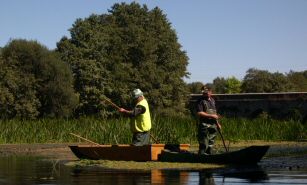
|

CONSERVATION WORK
Under the project Parga-Ladra-Támoga SCI: The recovery of woodland prone to swamping and its distrophic lake area, we are going to carry out actions on the physical area, they are included in what is called the the Unique Tasks of Management of the Biotype and Tasks of Periodical Management of the same.
| UNIQUE TASKS OF THE MANAGEMENT OF THE BIOTYPE |
PERIODICAL MANAGEMENT OF THE BIOTYPE
What we want to do is the restoration and protection of the zones which are specially damaged, both in the Miño Islands and in the Parga-Ladra Área. For this reason we are going to eliminate foreign species (eucalyptus, pine and black poplar) and we are going to clean the inorganic waste in canals and the bordering zones of the river and lagoons. At the same time we are going to plant native species to create small woods which will make this area go back to nature. All these works are designed for the existing species to be in their natural habitat , free of contamination and damaging agents.
The recuperation of the natural path, which will be designed on this area, allow us to enter the south of the island, and has a walk through the beautiful nature which surrounds this countryside.
As an innovative aspect, this natural area will have bands of vegetation which will act as green filters capable of impeding contaminating waste like slurry get into the river. It would be a pilot project which can be developed to other points where these environmental agressions can be detected and as a consequence, it will eliminate or reduce a great threat for this wet area.
Another reactions to be developed in the programme is the elimination of an invasive aquatic plant ( Azolla filiculoides Lamb .), which is present in the river Miño, fundamentally arround the Insuas do Miño . The remove of this species is necessary to avoid the competitive effect which it has on communities of other aquatic plants which ocupy the same ecological niche and they are negatively affected due to the diminishing of oxigene in the water which this invader causes.
To eliminate the species we are using the “batuxo”, (a small flat bottoned boat), traditional boat in the river Miño, which is made by craftsmen just for this job, and has been also used for environmental education work and for work to getting to know the area.
ENVIRONMENTAL MANAGEMENT
This kind of environmental intervention will also be used to reduce the negative effects which this natural area has been suffering and which are due to the changes in the use of the soil, destruction of places of interest which are of priority for the action of man and the evasion of foreign species, the elimination of species of community interest, the intensive use of the ground for building and leisure use and the lack of environmental sensibility.
As we are facing these threats we propose to develop integrated management oriented towards the future preservation of natural enclaves which have a rich flora and fauna. To this end the following measures have been proposed:
The elaboration and passing of a plan of the regulation of the SCI, the regulations regarding the use and activities of the 4934 hectares, the start of which has already published in the DOG the 13th of June 2003.
The purchasing of land by expropriating in order to conserve and preserve the nature. Initially this is 55.2 hectares of land which are destined to the protection and restoration of habitats and the species previously mentioned. In this aspect the Diputación Provincial de Lugo, with its own money, has financed, in a parallel way, the expropriation of other 60 hectares to ensure the environmental conservation of all the area of the Insuas do Miño and the Parga-Ladra Área .
The carrying out of different actions to improve the habitats and their surroundings (cleaning of canals, making vegetable screens, elimination of invasive species, recovery of small lagoons...)
Supervision and follow up of the quality levels of the ecosystem with special attention to the phisical and chemical parameters in the surroundings.
Environmental awareness tasks and difusion of the developed actions, based on environmental education activities among the local students. The information gathered will be divulged by seminars, exhibitions, publications and audiovisual material.






